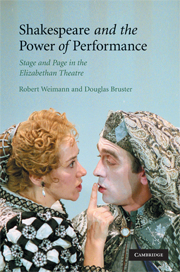Book contents
- Frontmatter
- Contents
- Acknowledgments
- Introduction
- Chapter 1 “Moralize two meanings” in one play: contrariety on the Tudor stage
- Chapter 2 Performance, game, and representation in Richard III
- Chapter 3 Mingling vice and “worthiness” in King John
- Chapter 4 Clowning: agencies between voice and pen
- Chapter 5 Clowning at the frontiers of representation
- Chapter 6 Cross-dressing and performance in disguise
- Chapter 7 Personation and playing: “secretly open” role-playing
- Chapter 8 Character/actor: the deep matrix
- Chapter 9 Character: depth, dialogue, page
- Chapter 10 King Lear: representations on stage and page
- Notes
- Index
- References
Chapter 8 - Character/actor: the deep matrix
Published online by Cambridge University Press: 22 September 2009
- Frontmatter
- Contents
- Acknowledgments
- Introduction
- Chapter 1 “Moralize two meanings” in one play: contrariety on the Tudor stage
- Chapter 2 Performance, game, and representation in Richard III
- Chapter 3 Mingling vice and “worthiness” in King John
- Chapter 4 Clowning: agencies between voice and pen
- Chapter 5 Clowning at the frontiers of representation
- Chapter 6 Cross-dressing and performance in disguise
- Chapter 7 Personation and playing: “secretly open” role-playing
- Chapter 8 Character/actor: the deep matrix
- Chapter 9 Character: depth, dialogue, page
- Chapter 10 King Lear: representations on stage and page
- Notes
- Index
- References
Summary
As we move from personation to characterization, it is paramount to dismiss the idea of any firm boundary between these two modes of dramatic figuration. To be sure, what has come to be thought of as “deep” characterization made itself most clearly manifest in early modern drama from the late 1590s onward. Here, as is well known, such characters as Brutus, Rosalind, and Hamlet helped inaugurate fascinating displays of “that within” (Hamlet, 1.2.85). Such displays accompanied a linguistic and behavioral self-consciousness that would, in the ensuing years, distinguish figures such as Lear, Cleopatra, the Duchess of Malfi, and Beatrice-Joanna, to name only these. To this limited extent, then, personation and characterization may be defined in relation to their respective chronologies, according to which, for a brief period, character emerged as a more comprehending image of subjectivity in the theatre. It was a vulnerable mode of selfhood because the groping for a new depth within was inseparable from presenting a worldly without. Between the two arose a relationship that, wanting precedent as well as precept, was beset by an unexplored, untested measure of both engagement and discrepancy. In such characterization any “secret close” (Richard III, 1.1.158) design of passion and desire could be made interactive with a rich, imaginary set of public objects and options, challenges, and charges.
In this way characterization goes beyond personation in the dramatic fashioning of subjectivity.
- Type
- Chapter
- Information
- Shakespeare and the Power of PerformanceStage and Page in the Elizabethan Theatre, pp. 160 - 177Publisher: Cambridge University PressPrint publication year: 2008

